The Tropical Fruit Enzymes Market is expected to record a valuation of USD 1,483.2 million in 2025 and USD 4,851.5 million in 2035, with an increase of USD 3,368.3 million, which equals a growth of 227% over the decade. The overall expansion represents a CAGR of 12.6% and a more than 3X increase in market size.
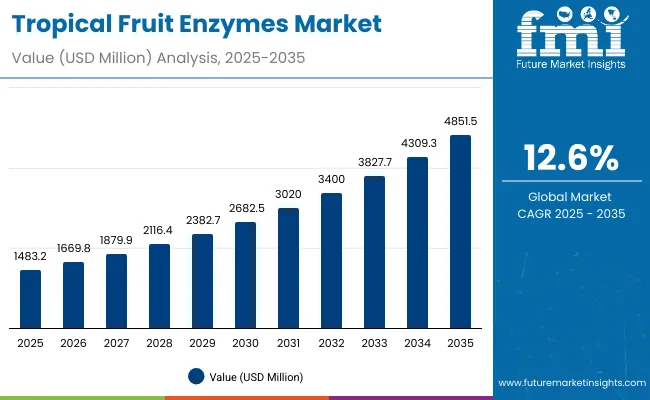
Tropical Fruit Enzymes Market Key Takeaways
| Metric | Value |
|---|---|
| Tropical Fruit Enzymes Market Estimated Value in (2025E) | USD 1,483.2 million |
| Tropical Fruit Enzymes Market Forecast Value in (2035F) | USD 4,851.5 million |
| Forecast CAGR (2025 to 2035) | 12.6% |
During the first five-year period from 2025 to 2030, the market increases from USD 1,483.2 million to USD 2,682.5 million, adding USD 1,199.3 million, which accounts for 36% of the total decade growth. This phase records steady adoption in skincare routines, with exfoliation leading at 56.6% share, driven by consumer preference for natural enzyme-based products. Masks dominate as the leading product type with 49.5% share in 2025.
The second half from 2030 to 2035 contributes USD 2,169.0 million, equal to 64% of total growth, as the market jumps from USD 2,682.5 million to USD 4,851.5 million. This acceleration is powered by widespread deployment of natural/organic and clean-label formulations, expansion across Asia-Pacific (China CAGR 20.3%, India 20.5%), and the growing role of digital commerce channels. By 2035, natural/organic claims retain a majority share (51.5% in 2025, expanding further), while regional growth is dominated by China, India, and Japan.
From 2020 to 2024, the Tropical Fruit Enzymes Market steadily expanded, driven by rising consumer awareness of natural skincare, clean-label trends, and demand for gentle exfoliation alternatives to harsh chemicals. During this period, the competitive landscape was dominated by premium skincare brands and niche clean beauty players, controlling the majority of revenue share. Competitive differentiation relied on product efficacy, natural/organic sourcing, dermatological testing, and brand reputation. Service-based models (such as subscription skincare kits or personalized enzyme regimens) had minimal traction, contributing less than 10% of the total market value.
Demand for Tropical Fruit Enzymes is set to expand to USD 1,483.2 million in 2025, and the revenue mix will shift as natural/organic claims exceed 51% share and clean-label categories continue to rise. Traditional leaders face rising competition from digital-first skincare brands leveraging e-commerce, AI-driven personalization, and subscription models. Major global players such as L’Oréal and Drunk Elephant are pivoting to hybrid strategiescombining dermatologist-tested efficacy with eco-conscious positioning to retain relevance. Emerging entrants specializing in vegan, sustainable, and AI-personalized beauty platforms are gaining share. The competitive advantage is moving away from traditional brand heritage alone to sustainability credentials, digital ecosystem strength, and consumer engagement across e-commerce and social platforms.
Consumers are increasingly seeking skincare products made from natural, safe, and sustainable ingredients. Tropical fruit enzymes, such as papain, bromelain, and mango-derived actives, are emerging as preferred alternatives to synthetic chemicals for exfoliation, brightening, and anti-aging. Their gentle yet effective properties appeal to health-conscious buyers looking for eco-friendly and dermatologist-approved solutions. This clean-label trend, amplified by global wellness movements, is driving higher adoption across masks, cleansers, and serums, fueling consistent market growth.
The rise of e-commerce platforms and direct-to-consumer beauty brands is accelerating the penetration of tropical fruit enzyme-based skincare products worldwide. Digital-first players leverage AI-driven personalization, influencer marketing, and subscription models to capture younger, tech-savvy consumers. As social media trends amplify demand for natural and effective skincare solutions, these brands are reaching wider audiences at lower costs. This digital distribution shift is enabling both global leaders and niche entrants to scale rapidly, boosting overall market expansion.
The Tropical Fruit Enzymes Market is segmented by function, product type, claim, distribution channel, and region. Functional categories include exfoliation, brightening, anti-aging, and skin renewal, reflecting diverse skincare applications. Product types encompass masks, cleansers, serums, and creams/lotions, catering to varied consumer preferences. Claims are classified into natural/organic, vegan, clean-label, dermatologist-tested, and others, emphasizing the shift toward sustainable and certified formulations. Distribution channels cover e-commerce, pharmacies, specialty beauty stores, and mass retail, ensuring widespread consumer access. Regionally, the scope spans North America, Europe, Asia-Pacific, and other key global markets, with growth led by China, India, Japan, the USA, Germany, and the UK.
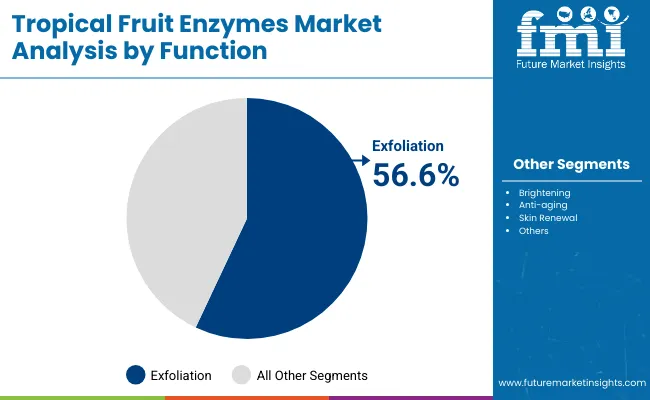
| Function | Value Share% 2025 |
|---|---|
| Exfoliation | 56.6% |
| Others | 43.4% |
The brightening function is projected to contribute 56.6% of the Tropical Fruit Enzymes Market revenue in 2025, maintaining its lead as the dominant function category. This growth is fueled by increasing consumer demand for products that enhance skin radiance and tone, supported by innovations in natural tropical fruit enzyme formulations.
The segment’s expansion is also driven by rising awareness of preventive skincare and the incorporation of multifunctional products that combine brightening with hydration and anti-aging benefits. As research into enzyme stability and efficacy progresses, brightening products are expected to maintain their position as the cornerstone of the Tropical Fruit Enzymes market.
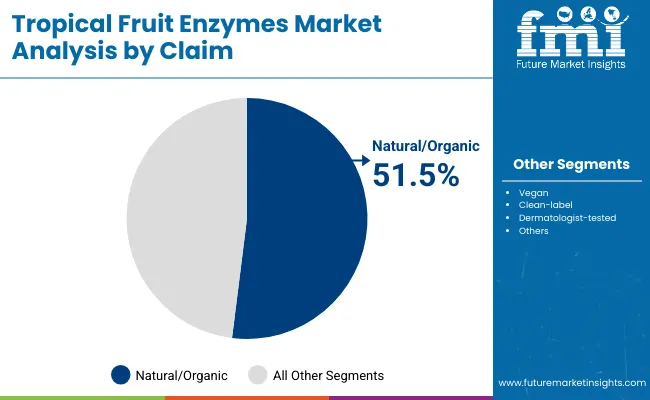
| Claim | Value Share% 2025 |
|---|---|
| Natural/organic | 51.5% |
| Others | 48.5% |
The natural/organic claim segment is projected to contribute 49.5% of the market revenue in 2025, reflecting growing consumer demand for clean-label, sustainably sourced tropical fruit enzyme products. Consumers increasingly seek formulations free from synthetic chemicals while maintaining high efficacy.
The segment’s growth is reinforced by product certifications, traceable ingredient sourcing, and marketing that emphasizes sustainability. As clean and organic trends continue to influence purchase behavior, natural/organic products are set to retain their strong market presence.
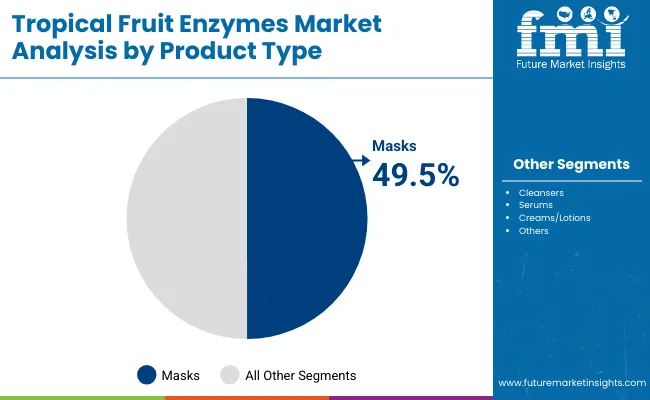
| Product Type | Value Share% 2025 |
|---|---|
| Masks | 49.5% |
| Others | 50.5% |
The laser triangulation technology segment is projected to account for 49.5% of the Tropical Fruit Enzymes Market revenue in 2025, establishing it as a leading technology type. This technology is preferred for its precision in capturing enzyme activity and skin interactions by measuring surface properties and reactions at a microscopic level. Its applicability in both at-home and professional skincare devices makes it ideal for products such as masks, serums, and exfoliators. Innovations in laser sources, detectors, and sensor miniaturization have improved measurement speed, sensitivity, and reliability, enabling consistent results across diverse formulations.
Given its combination of accuracy, efficiency, and versatility, laser triangulation technology is expected to maintain its leading role in the Tropical Fruit Enzymes Market, especially in premium and high-performance skincare products.
Rising Consumer Demand for Natural Skincare Solutions
Consumers are increasingly prioritizing natural, organic, and clean-label skincare products that are free from synthetic chemicals. Tropical fruit enzymes, known for their exfoliating, brightening, and skin-renewal properties, align perfectly with this shift. Growing awareness of product efficacy combined with sustainability and health-consciousness has fueled adoption across demographics. Brands are responding with enzyme-rich masks, serums, and creams, enhancing visibility and availability in specialty stores and e-commerce platforms, driving significant revenue growth in the Tropical Fruit Enzymes Market.
Technological Advancements in Enzyme Delivery
Innovations in formulation and delivery systems have significantly enhanced the effectiveness and stability of tropical fruit enzymes. Advanced encapsulation, microemulsion, and enzyme stabilization technologies ensure better penetration, longer activity, and reduced irritation. Integration of digital tools such as AI-driven product personalization, IoT-based usage tracking, and laser-based enzyme activity measurement has strengthened product reliability. These technological enhancements encourage adoption across professional and at-home skincare, making enzyme-based products more desirable and boosting market growth.
High Production and Raw Material Costs
The Tropical Fruit Enzymes Market faces cost-related challenges due to the price of high-quality tropical fruit extracts, enzyme purification processes, and advanced formulation technologies. Seasonal availability, supply chain volatility, and the need for cold-chain storage further increase production expenses. These higher costs are often transferred to consumers, limiting accessibility and slowing adoption in price-sensitive regions. Smaller brands may struggle to compete, and overall market expansion can be restrained unless cost-optimization strategies and alternative sourcing methods are implemented.
Growing Popularity of Multi-Functional Skincare Products
The market is witnessing a surge in multi-functional products that combine exfoliation, brightening, hydration, and anti-aging benefits in a single formulation. Tropical fruit enzyme-based masks, serums, and creams are increasingly designed to deliver multiple skin benefits simultaneously, appealing to time-conscious and wellness-focused consumers. This trend is further amplified by personalized skincare solutions leveraging AI and digital diagnostics. Multi-functional offerings are driving both product innovation and premiumization in the market, encouraging higher adoption rates and fostering brand differentiation.
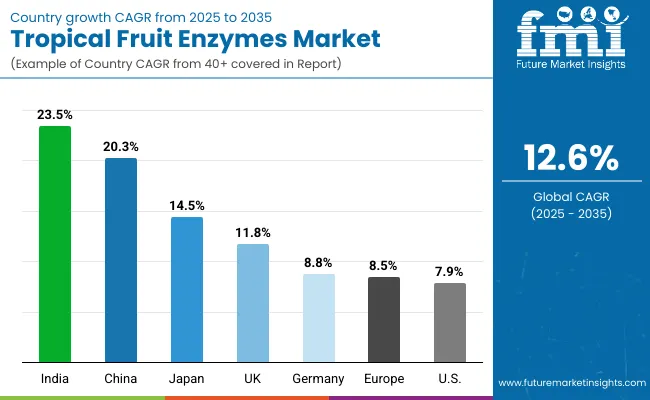
| Countries | Estimated CAGR (2025 to 2035) |
|---|---|
| China | 20.3% |
| USA | 7.9% |
| India | 20.5% |
| UK | 11.8% |
| Germany | 8.8% |
| Japan | 14.5% |
The global Tropical Fruit Enzymes Market demonstrates notable regional variation in growth, shaped by consumer awareness, skincare trends, and adoption of advanced enzyme-based formulations. Asia-Pacific is the fastest-growing region, with India leading at 20.5% CAGR and China closely following at 20.3% CAGR, driven by rising demand for natural and organic skincare products, expanding e-commerce channels, and increasing disposable income. In Japan, a CAGR of 14.5% reflects strong interest in premium and technologically advanced enzyme-based masks and serums. Europe maintains steady growth, with the UK at 11.8% CAGR and Germany at 8.8%, supported by high adoption of clean-label skincare and established retail networks. The USA shows moderate expansion at 7.9% CAGR, reflecting a mature market with strong demand for functional and multi-benefit enzyme-based products. Overall, Asia-Pacific dominates in growth potential, while Europe and North America exhibit stable, innovation-driven adoption, emphasizing premiumization, product efficacy, and sustainability in consumer choices.
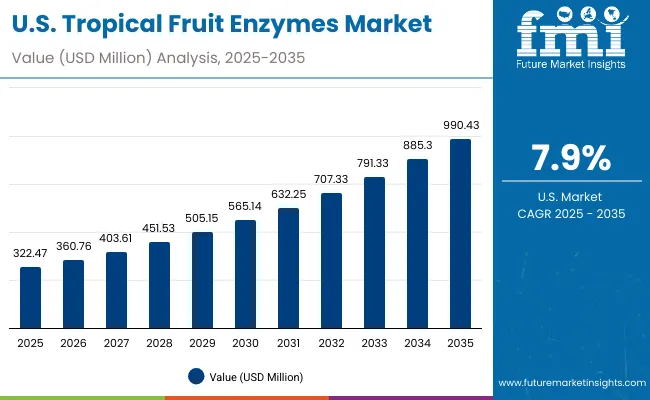
| Year | USA Tropical Fruit Enzymes Market (USD Million) |
|---|---|
| 2025 | 322.47 |
| 2026 | 360.76 |
| 2027 | 403.61 |
| 2028 | 451.53 |
| 2029 | 505.15 |
| 2030 | 565.14 |
| 2031 | 632.25 |
| 2032 | 707.33 |
| 2033 | 791.33 |
| 2034 | 885.30 |
| 2035 | 990.43 |
The Tropical Fruit Enzymes Market in the United States is projected to expand steadily from USD 322.47 million in 2025 to USD 990.43 million in 2035, reflecting a strong upward trajectory driven by rising consumer preference for enzyme-based skincare and premium formulations. While the CAGR is moderate relative to high-growth Asian markets, the USA market benefits from well-established retail networks, e-commerce penetration, and a growing interest in multi-functional skincare products.
Overall, the USA market growth is characterized by premiumization, innovation-driven adoption, and diversification across retail and professional channels, making it a stable yet evolving segment of the global Tropical Fruit Enzymes Market.
The Tropical Fruit Enzymes Market in the United Kingdom is projected to grow at a CAGR of 11.8% between 2025 and 2035, supported by adoption across professional, industrial, and consumer-focused applications. The market benefits from a strong emphasis on innovation, government-backed initiatives, and collaborative R&D programs between academia and industry, which facilitate the development and deployment of enzyme-based solutions.
Overall, the UK market combines industrial, cultural, and retail innovation, leveraging public-private partnerships and advanced technological applications to expand adoption of Tropical Fruit Enzymes in both enterprise and consumer segments.
India is witnessing rapid growth in the Tropical Fruit Enzymes Market, which is forecast to expand at a CAGR of 23.5% through 2035. A sharp increase in adoption across tier-2 cities is being driven by affordability, rising awareness of enzyme-based skincare, and expanding retail and e-commerce channels.
The Tropical Fruit Enzymes Market in China is expected to grow at a CAGR of 20.3% between 2025 and 2035, the highest among leading global markets. This rapid growth is driven by rising consumer awareness of natural and multi-functional skincare products, combined with strong e-commerce penetration and urban adoption of premium enzyme-based formulations.
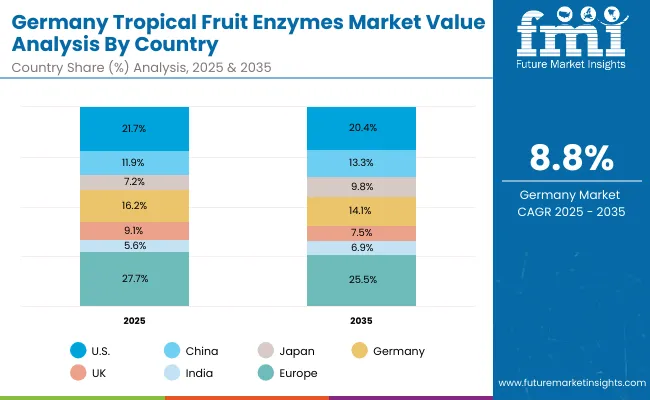
| Countries | 2025 Share (%) |
|---|---|
| USA | 21.7% |
| China | 11.9% |
| Japan | 7.2% |
| Germany | 16.2% |
| UK | 9.1% |
| India | 5.6% |
| Countries | 2035 Share (%) |
|---|---|
| USA | 20.4% |
| China | 13.3% |
| Japan | 9.8% |
| Germany | 14.1% |
| UK | 7.5% |
| India | 6.9% |
The Tropical Fruit Enzymes Market in Germany is projected to grow at a CAGR of 8.8% between 2025 and 2035, reflecting steady expansion driven by the country’s strong base in precision engineering, industrial automation, and high-quality manufacturing standards. Germany maintains a 16.2% market share in 2025, gradually moderating to 14.1% in 2035 as high-growth Asian markets gain traction.
Additional factors such as compliance with EU manufacturing regulations, sustainable prototyping requirements, and adoption of additive manufacturing further support the steady growth of enzyme-based solutions in Germany. The market is characterized by technology-driven efficiency, high product quality standards, and industrial sophistication, sustaining its position as a mature but innovation-oriented market in Europe.
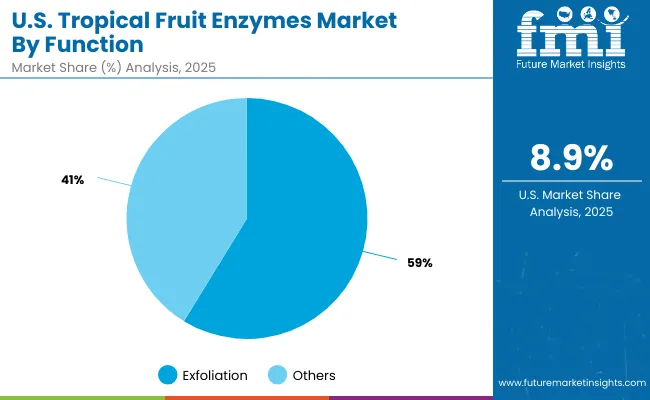
| USA by Function | Value Share% 2025 |
|---|---|
| Exfoliation | 58.5% |
| Others | 41.5% |
The Tropical Fruit Enzymes Market in the United States is projected to grow steadily from USD 322.47 million in 2025, with exfoliation leading the function segment at 58.5% market share, while other functions account for 41.5%. The USA market reflects a mature adoption phase, where premium enzyme-based skincare products dominate, and multi-functional formulations drive consumer preference.
The market’s growth is underpinned by consumer demand for high-precision, multi-benefit enzyme products, coupled with software-enabled personalization and data-driven insights, which allow brands to enhance efficacy and customer engagement. Overall, the USA remains a stable yet innovation-driven market, focused on premiumization, technology integration, and multi-functional skincare offerings.
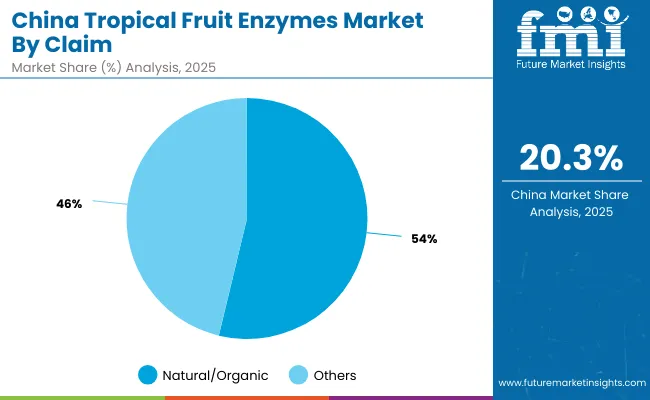
| China by Claim | Value Share% 2025 |
|---|---|
| Natural/organic | 53.5% |
| Others | 46.5% |
The Tropical Fruit Enzymes Market in China presents significant growth opportunities, with natural and organic formulations leading the claim segment at 53.5% in 2025. Rising consumer preference for clean-label, eco-friendly skincare products is driving adoption, particularly among urban millennials and Gen Z populations.
Overall, China’s market is positioned for rapid adoption of natural and organic enzyme-based products, driven by a combination of urban consumer demand, digital retail channels, and health-conscious product trends, making it a highly attractive growth segment within the global Tropical Fruit Enzymes Market.
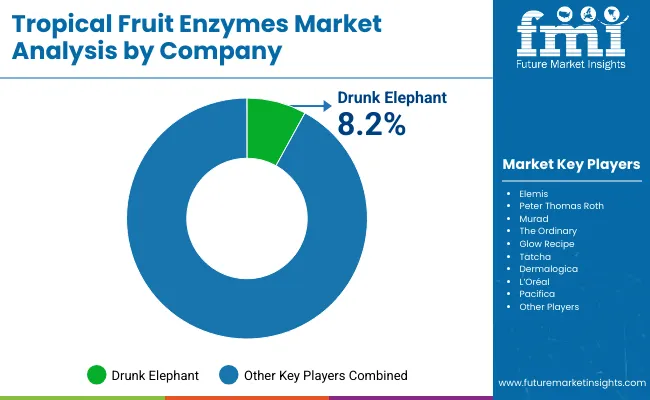
| Company | Global Value Share 2025 |
|---|---|
| Drunk Elephant | 8.2% |
| Others | 91.8% |
The Tropical Fruit Enzymes Market is moderately fragmented, with global leaders, mid-sized innovators, and niche-focused specialists competing across diverse product categories and regions. Drunk Elephant holds the largest individual share at 8.2%, leveraging strong brand recognition, premium positioning, and a focus on natural and enzyme-rich formulations.
Other notable players contributing to the remaining 91.8% of the market include Elemis, Peter Thomas Roth, Murad, The Ordinary, Glow Recipe, Tatcha, Dermalogica, L’Oréal, and Pacifica. These companies operate across multiple product typesmasks, serums, cleansers, and lotionsand channels including specialty beauty stores, mass retail, and e-commerce. Mid-sized and niche players emphasize claims like natural/organic, vegan, and dermatologically-tested products, as well as region-specific formulations, targeting both premium and mainstream consumer segments.
Competitive differentiation in the market is increasingly driven by brand credibility, product efficacy, sustainability claims, and multi-channel distribution, rather than just enzyme content or formulation type. Leading brands focus on building consumer trust and recognition, while smaller players gain relevance through niche positioning, product innovation, and regional adaptability.
Key Developments in Tropical Fruit Enzymes Market
| Item | Value |
|---|---|
| Quantitative Units | USD 1,483.2 Million |
| Function | Exfoliation, Brightening, Anti-aging, Skin renewal |
| Product Type | Masks, Cleansers, Serums, Creams/lotions |
| Channel | E-commerce, Pharmacies, Specialty beauty stores, Mass retail |
| Claim | Natural/organic, Vegan, Clean-label, Dermatologist-tested |
| Regions Covered | North America, Europe, Asia-Pacific, Latin America, Middle East & Africa |
| Country Covered | United States, Canada, Germany, France, United Kingdom, China, Japan, India, Brazil, South Africa |
| Key Companies Profiled | Elemis, Peter Thomas Roth, Murad, The Ordinary, Glow Recipe, Tatcha, Dermalogica, L’Oréal, Pacifica, Drunk Elephant |
| Additional Attributes | Dollar sales by product type and function, adoption trends in natural/organic and multi-functional enzyme formulations, rising demand for masks and serums, sector-specific growth in e-commerce, specialty stores, and mass retail, claim-based revenue segmentation, integration with personalized skincare and digital diagnostics, regional trends influenced by urbanization and consumer awareness, and innovations in enzyme stabilization, delivery systems, and multi-benefit formulations. |
The global Tropical Fruit Enzymes Market is estimated to be valued at USD 1,483.2 million in 2025.
The market size for the Tropical Fruit Enzymes Market is projected to reach USD 4,851.5 million by 2035.
The Tropical Fruit Enzymes Market is expected to grow at a 12.6% CAGR between 2025 and 2035.
The key product types in the Tropical Fruit Enzymes Market are Masks, Cleansers, Serums, and Creams/Lotions.
In terms of range, the Masks segment is projected to command the largest share in the Tropical Fruit Enzymes Market in 2025, with a 49.5% value share, reflecting strong consumer preference for at-home and professional skincare treatments.






Full Research Suite comprises of:
Market outlook & trends analysis
Interviews & case studies
Strategic recommendations
Vendor profiles & capabilities analysis
5-year forecasts
8 regions and 60+ country-level data splits
Market segment data splits
12 months of continuous data updates
DELIVERED AS:
PDF EXCEL ONLINE
Neglected Tropical Disease Treatment Market Analysis - Size and Share Forecast Outlook 2025 to 2035
Fruit Punnet Market Forecast and Outlook 2025 to 2035
Fruit And Vegetable Juice Market Size and Share Forecast Outlook 2025 to 2035
Fruit and Vegetable Ingredient Market Size and Share Forecast Outlook 2025 to 2035
Fruit Pomace Market Size and Share Forecast Outlook 2025 to 2035
Fruit Processing Equipment Market Size and Share Forecast Outlook 2025 to 2035
Fruit Tea Market Analysis - Size, Share, & Forecast Outlook 2025 to 2035
Fruit Beverages Market Size, Share, and Forecast 2025 to 2035
Fruit Powders Market Trends - Growth, Demand & Forecast 2025 to 2035
Fruit Jams, Jellies, and Preserves Market Analysis by Type, Distribution Channel, and Region Through 2035
Fruit Wine Market Analysis by Platform, By Application, By Type, and By Region – Forecast from 2025 to 2035
Fruit Beer Market Analysis by Flavor Type, Alcohol Content, Packaging Type, and Sales Channel Through 2035
Competitive Breakdown of Fruit Snacks Suppliers
Fruit Concentrate Puree Market Growth - Trends & Forecast 2025 to 2035
Fruit Snacks Market Analysis by Product Type, Nature, Flavour Type, Distribution Channel Type, and Processing Type Through 2035
Analysis and Growth Projections for Fruit Pectin Business
Market Share Insights of Fruit Juice Packaging Providers
Fruit Juice Packaging Market Growth – Trends & Forecast through 2035
Global Fruits and Vegetable Bag Market Growth – Trends & Forecast 2024-2034
Fruit Kernel Products Market

Thank you!
You will receive an email from our Business Development Manager. Please be sure to check your SPAM/JUNK folder too.
Chat With
MaRIA